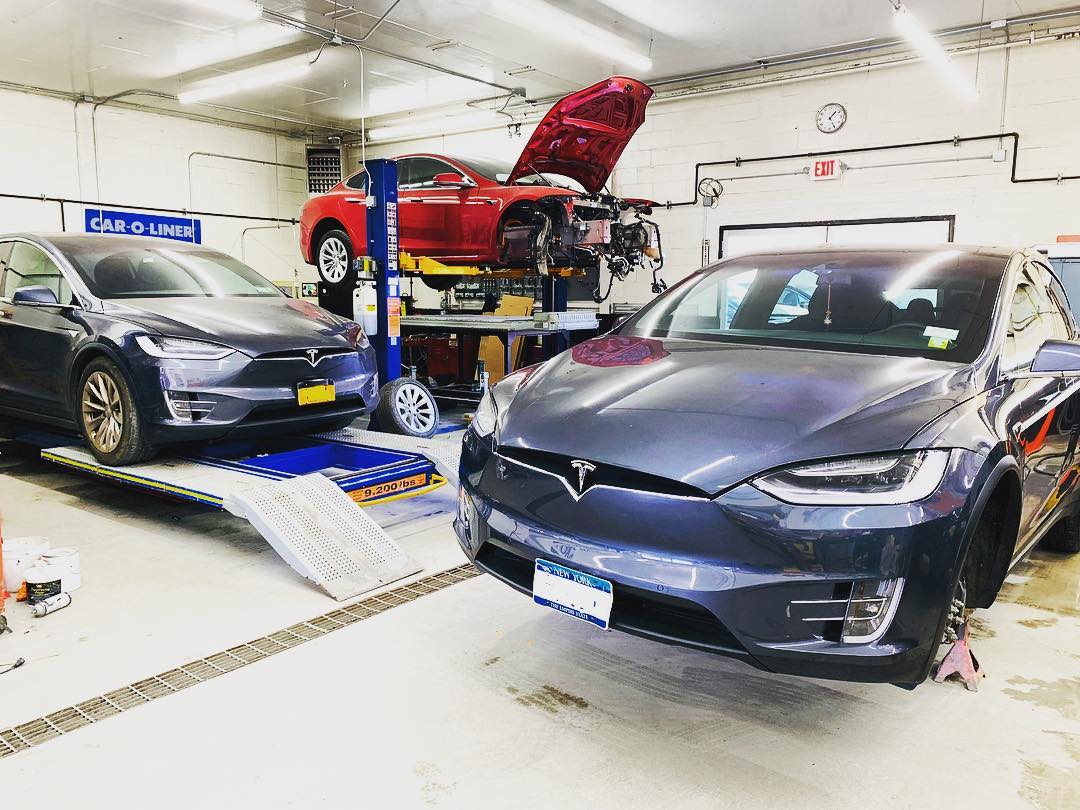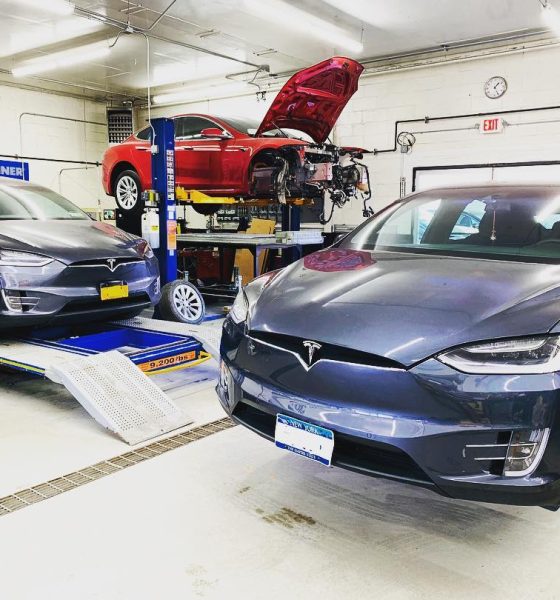

News
Tesla repair costs are causing insurance providers to write off low-mileage EVs: report
While Elon Musk noted during the Q4 and FY 2022 earnings call that data from Tesla Insurance is helping the company minimize vehicle repair costs, the story seems different for Teslas that are covered by other insurance providers. As per a recent report, even low-mileage Teslas are already being written off by insurance companies.
Elon Musk described Tesla’s efforts to lower its vehicles’ cost of repair in the recent earnings call. “We’ve actually adjusted the design of the car and made changes in the software of the car to minimize the cost of repair… So it’s giving us this really good feedback before, again, reducing cost,” Musk said.
Outside Tesla Insurance’s coverage, the situation is different, at least according to a Reuters analysis. Data from Copart and IAA, which are among the largest salvage auction houses in the US, indicated that many “totaled” Model Y units listed for auction in December and January had fewer than 10,000 miles on their odometers. Considering that these vehicles were bought prior to Tesla’s price cuts earlier this month, the retail prices of the cars were about $60,000 to over $80,000.
Insurance companies usually consider a vehicle a total loss when the cost of repairing it is deemed too high. Interestingly enough, out of the 15 Giga Texas-made Model Y Long Range vehicles that were part of the publication’s analysis and declared as total losses from June to November, 14 had fewer than 10,000 miles on their odometers.
These include a Giga Texas-made 2022 Model Y Long Range, which was listed by IAA with front collision damage in early January. The vehicle had a retail price of $61,388 and an estimated repair cost of $50,388. Another Model Y, which was listed with side collision damage, had a retail price of $72,667 and an estimated repair cost of $43,814.
As per Reuters’ analysis, several prominent insurance companies such as State Farm, Geico, Progressive, and Farmers, are among the providers that have considered low-mileage damaged Teslas too expensive to repair.
Considering the estimates for the repair of damaged Teslas, it is no surprise that some insurance companies are opting to write off the damaged vehicles as total losses. It’s difficult to argue, however, that such a strategy is wasteful. At this point, it seems like the best-case scenario for Tesla is to ramp up the expansion of its insurance service. This way, its owners are not burdened by insurance providers that do not seem to fully understand their vehicles.
Elon Musk said as much during the fourth quarter and full-year 2022 earnings call last week, when he explained how Tesla Insurance is giving the company a good feedback loop on how to optimize the costs of its vehicles’ repair.
“It is also giving us a good feedback loop into minimizing the cost of repair of Teslas — for all Teslas worldwide — because we obviously want to minimize the cost of repairing a Tesla if it’s in a collision… And previously, we didn’t actually have good insight into that because the other insurance companies would cover the cost. And actually, the cost in some cases were unreasonably high,” Musk said.
The Teslarati team would appreciate hearing from you. If you have any tips, contact me at maria@teslarati.com or via Twitter @Writer_01001101.

Elon Musk
Starlink achieves major milestones in 2025 progress report
Starlink wrapped up 2025 with impressive growth, adding more than 4.6 million new active customers and expanding service to 35 additional countries, territories, and markets.

Starlink wrapped up 2025 with impressive growth, adding more than 4.6 million new active customers and expanding service to 35 additional countries, territories, and markets. The company also completed deployment of its first-generation Direct to Cell constellation, launching over 650 satellites in just 18 months to enable cellular connectivity.
SpaceX highlighted Starlink’s impressive 2025 progress in an extensive report.
Key achievements from Starlink’s 2025 Progress
Starlink connected over 4.6 million new customers with high-speed internet while bringing service to 35 more regions worldwide in 2025. Starlink is now connecting 9.2 million people worldwide. The service achieved this just weeks after hitting its 8 million customer milestone.
Starlink is now available in 155 markets, including areas that are unreachable by traditional ISPs. As per SpaceX, Starlink has also provided over 21 million airline passengers and 20 million cruise passengers with reliable high-speed internet connectivity during their travels.
Starlink Direct to Cell
Starlink’s Direct to Cell constellation, more than 650 satellites strong, has already connected over 12 million people at least once, marking a breakthrough in global mobile coverage.
Starlink Direct to Cell is currently rolled out to 22 countries and 6 continents, with over 6 million monthly customers. Starlink Direct to Cell also has 27 MNO partners to date.
“This year, SpaceX completed deployment of the first generation of the Starlink Direct to Cell constellation, with more than 650 satellites launched to low-Earth orbit in just 18 months. Starlink Direct to Cell has connected more than 12 million people, and counting, at least once, providing life-saving connectivity when people need it most,” SpaceX wrote.
News
Giga Nevada celebrates production of 6 millionth drive unit
To celebrate the milestone, the Giga Nevada team gathered for a celebratory group photo.

Tesla’s Giga Nevada has reached an impressive milestone, producing its 6 millionth drive unit as 2925 came to a close.
To celebrate the milestone, the Giga Nevada team gathered for a celebratory group photo.
6 million drive units
The achievement was shared by the official Tesla Manufacturing account on social media platform X. “Congratulations to the Giga Nevada team for producing their 6 millionth Drive Unit!” Tesla wrote.
The photo showed numerous factory workers assembled on the production floor, proudly holding golden balloons that spelled out “6000000″ in front of drive unit assembly stations. Elon Musk gave credit to the Giga Nevada team, writing, “Congrats on 6M drive units!” in a post on X.
Giga Nevada’s essential role
Giga Nevada produces drive units, battery packs, and energy products. The facility has been a cornerstone of Tesla’s scaling since opening, and it was the crucial facility that ultimately enabled Tesla to ramp the Model 3 and Model Y. Even today, it serves as Tesla’s core hub for battery and drivetrain components for vehicles that are produced in the United States.
Giga Nevada is expected to support Tesla’s ambitious 2026 targets, including the launch of vehicles like the Tesla Semi and the Cybercab. Tesla will have a very busy 2026, and based on Giga Nevada’s activities so far, it appears that the facility will be equally busy as well.
News
Tesla Supercharger network delivers record 6.7 TWh in 2025
The network now exceeds 75,000 stalls globally, and it supports even non-Tesla vehicles across several key markets.

Tesla’s Supercharger Network had its biggest year ever in 2025, delivering a record 6.7 TWh of electricity to vehicles worldwide.
To celebrate its busy year, the official @TeslaCharging account shared an infographic showing the Supercharger Network’s growth from near-zero in 2012 to this year’s impressive milestone.
Record 6.7 TWh delivered in 2025
The bar chart shows steady Supercharger energy delivery increases since 2012. Based on the graphic, the Supercharger Network started small in the mid-2010s and accelerated sharply after 2019, when the Model 3 was going mainstream.
Each year from 2020 onward showed significantly more energy delivery, with 2025’s four quarters combining for the highest total yet at 6.7 TWh.
This energy powered millions of charging sessions across Tesla’s growing fleet of vehicles worldwide. The network now exceeds 75,000 stalls globally, and it supports even non-Tesla vehicles across several key markets. This makes the Supercharger Network loved not just by Tesla owners but EV drivers as a whole.
Resilience after Supercharger team changes
2025’s record energy delivery comes despite earlier 2024 layoffs on the Supercharger team, which sparked concerns about the system’s expansion pace. Max de Zegher, Tesla Director of Charging North America, also highlighted that “Outside China, Superchargers delivered more energy than all other fast chargers combined.”
Longtime Tesla owner and FSD tester Whole Mars Catalog noted the achievement as proof of continued momentum post-layoffs. At the time of the Supercharger team’s layoffs in 2024, numerous critics were claiming that Elon Musk was halting the network’s expansion altogether, and that the team only remained because the adults in the room convinced the juvenile CEO to relent.
Such a scenario, at least based on the graphic posted by the Tesla Charging team on X, seems highly implausible.








